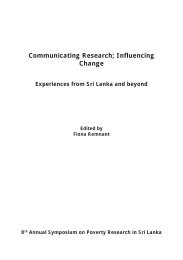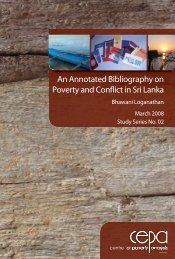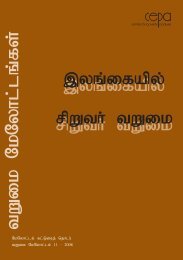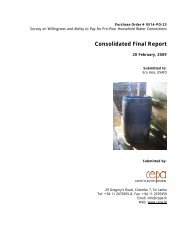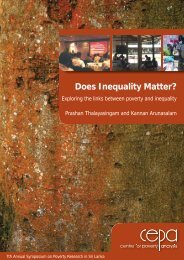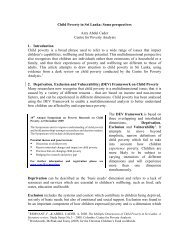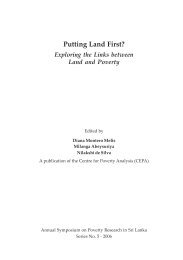Involuntary Displacement and Resettlement â Policy and ... - CEPA
Involuntary Displacement and Resettlement â Policy and ... - CEPA
Involuntary Displacement and Resettlement â Policy and ... - CEPA
- No tags were found...
Create successful ePaper yourself
Turn your PDF publications into a flip-book with our unique Google optimized e-Paper software.
The third difference may be the availability of support for livelihoodrestoration. Such support can come from either the government ornon-governmental sectors. Both these channels of support may not operate atthe same capacity in the CID <strong>and</strong> DID cases. The government channel wouldsurely be operational in the DID setting but political or economic issues maydetermine its effectiveness. In contrast, in the CID setting, governments cansometimes deliberately refrain from support activities. Further, for variousreasons, the government sector is sometimes seen to block or hinder thework done by NGOs to restore the livelihoods of conflict affected IDPs. Thistoo, may be determined by geopolitical aspirations. This point has a closebearing on the criticism of the IRLR model based on its ‘state centric’ nature(Muggah 2000: 213) (Amirthalingam <strong>and</strong> Lakshman 2009).10 ConclusionIn interviews <strong>and</strong> responses to questionnaires, IDP communities in Batticaloa,eastern Sri Lanka, regularly highlighted the significance of livelihoods forshoring up coping strategies. In this study we have been able to uncover <strong>and</strong>more importantly, provide an economic quantification of the increasedimpoverishment risk that sets in with loss of livelihoods due to displacement.We have been able to study important processes identified in Cernea’s IRLR,or the impoverishment model, within the livelihood-poverty framework.The focus of the paper is on incomes <strong>and</strong> other economic repercussions ofhaving or not having livelihoods after displacement. To do this we had toextend the resettler’s income curve of Cernea to suit the CID situations.Empirical findings of the paper overwhelmingly support our extension, whichwe call the CID income curve. There is evidence that the median of percapita income of the conflict IDPs was a fraction of the median of theirpre-displacement per capita income. In addition, the median income beforedisplacement was below per capita GDP of the country as a whole. This wasinterpreted as evidence that the income of the people of Sampur was alreadybelow potential level, even before they were displaced. There is alsoevidence that the variance of income also dropped with displacement. Thishowever cannot be incorporated into the CID income curve analysis.Another important finding of the study was that different types of livelihoodsrespond differently to displacement. Using these varying responses as thebasis we divided the livelihoods into four types: Type I Labour, Type IILabour, Government Servants <strong>and</strong> Asset Holders. The study provided79



